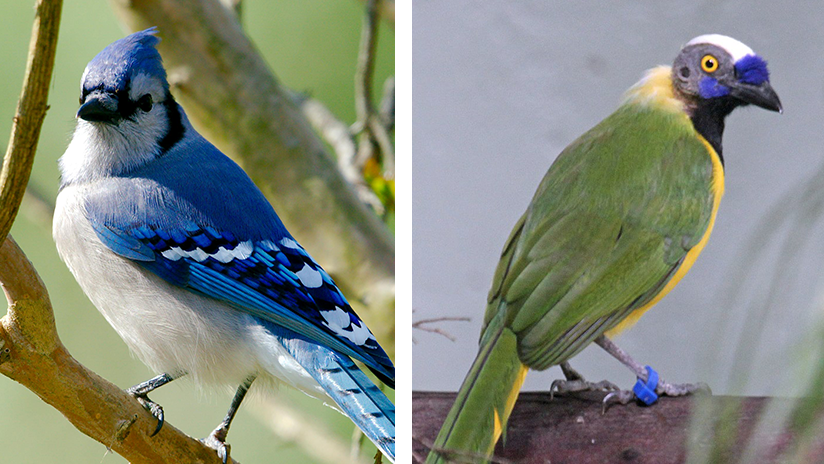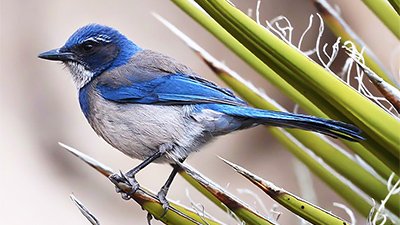Bowerbird’s Artistic Sense
Before the discovery of bowerbirds’ optical effects, only humans were known to design optical illusions. But does the bowerbird possess an artistic sense like humans?
News Source
While a common bird to Australia, the bowerbird shows an uncommon ability to design bowers—structures that look like two-sided thatch huts—to impress possible mates. The males spend much of their days gathering material to build and decorate the bowers with items from sticks and acorns to flowers and shells. The better the bower, the better the chance of winning a mate.
Researchers report in Current Biology about a new aspect of the bowerbirds’ architecture. The great bowerbird appears to build its bower using a special optical effect. Since the effect only works from a certain angle, the male creates an aisle for the female to look down towards the “stage” displaying the male. By carefully arranging objects on either side of the aisle in increasing size from the female, it seems that the male may have designed it so that he appears bigger and grander at the other end. When researchers changed the pattern by putting the larger rocks farther from the stage, the bowerbirds switched back to the original pattern in three days.
“Great bowerbirds are the first known animals besides humans who create a scene with altered visual perspective for viewing by other individuals,” John Endler of Deakin University in Australia said. He compares the bowerbirds’ design to the altered visual perspective that humans use to make structures, such as scenes at an amusement park, appear bigger than reality.
While research continues to test whether the bowerbirds purposefully arrange for optical effect, Endler speculates on this ultimate question: “Is it art?” After all, in 1872 the first European naturalist to see a structurally sound and artistically decorated bower thought the builder was human.1 The male bowerbird building for artistic attraction and the female judging between the different bowers does indicate, according to Endler, “an aesthetic sense in birds.”
Evolutionists often seek to find natural explanations for distinct human aspects like aesthetics, moral consciousness, and self-consciousness. The bowerbirds’ apparent art appreciation seems to allow the most genetically fit to survive according to biologist Gerry Borgia of the University of Maryland.2 But do male bowerbirds intellectually conceive the idea of the optical illusion, and do female bowerbirds intentionally judge the design as artistic?
Rather than an intellectual intention towards art, the great bowerbird instinctively builds remarkable structures, and the female instinctively responds to the optical effect, as programmed by the Creator. Only man, created in the image of God, has a true aesthetic sense. When appreciating the beauty and design of creatures like the bowerbird, the wise aesthetic judge praises the Creator of both art and beauty.
Further Reading
- Get Answers: Design in Nature
For More Information: Get Answers
Remember, if you see a news story that might merit some attention, let us know about it! (Note: if the story originates from the Associated Press, FOX News, MSNBC, the New York Times, or another major national media outlet, we will most likely have already heard about it.) And thanks to all of our readers who have submitted great news tips to us. If you didn’t catch all the latest News to Know, why not take a look to see what you’ve missed?
(Please note that links will take you directly to the source. Answers in Genesis is not responsible for content on the websites to which we refer. For more information, please see our Privacy Policy.)
Footnotes
- “Are Bowers Art?,” NOVA Online, http://www.pbs.org/wgbh/nova/bowerbirds/art.html.
- Christopher Joyce, “In Evolution, a Taste for Beauty Has a Purpose,” NPR, October 4, 2004, http://www.npr.org/2004/10/04/4057069/in-evolution-a-taste-for-beauty-has-a-purpose.
Recommended Resources

Answers in Genesis is an apologetics ministry, dedicated to helping Christians defend their faith and proclaim the good news of Jesus Christ.
- Customer Service 800.778.3390
- Available Monday–Friday | 9 AM–5 PM ET
- © 2025 Answers in Genesis




